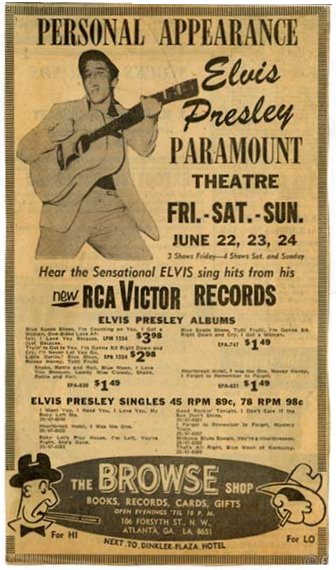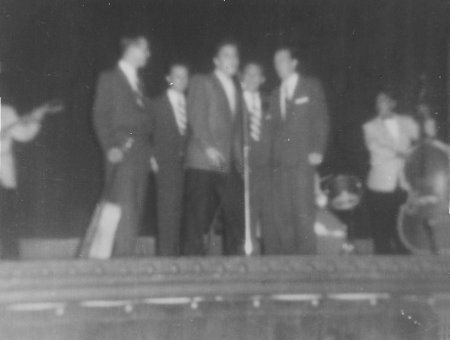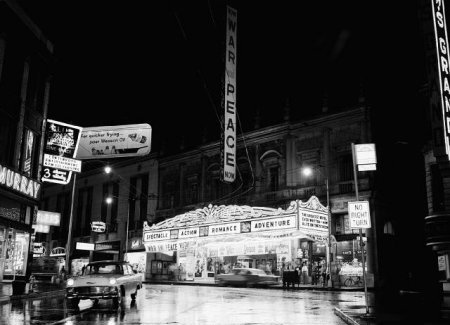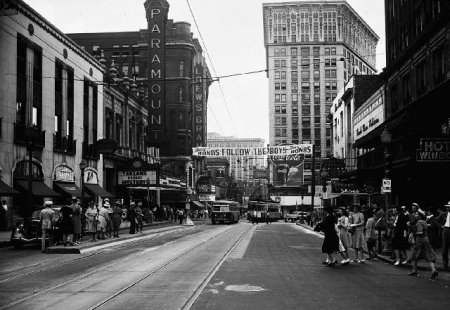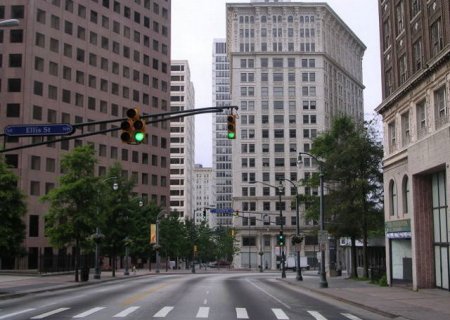 |
The Paramount Theater - Atlanta, GA
Troupe Howard of Georgia in the late 1890's went to Liverpool, England and made his fortune as a cotton dealer. In 1916 he returned to Atlanta and continued his cotton business but as a side line got involved in the growing motion picture industry and decided to build not just a movie theatre, but a movie palace. Designed by one of Atlanta's leading architectural firms, Hentz, Reid, and Alder, the only stipulation that Mr. Howard placed on the architects and the contractors was that his theatre was to have "the very best that money could buy". The new theatre was actually based on many features of palaces in Italy, and demonstrated a cohesiveness in design that was not always found in buildings of this type. The basic theme of the building was based in the 17th century Italian Renaissance. The original design of the facade was created by Philip Trammel Shutze. In its final form, it was perhaps one of the most beautiful facades to ever grace Peachtree Street. On December 13, 1920 the Howard Theatre officially opened its doors and what greeted the citizens of Atlanta would make them think that they had just gotten off the boat in Venice. T here was no marquee at this time, but a roof-top electric sign featuring two pots of gold. Built by the Buhler Company of Columbus, GA it was the largest electric sign in the city.
Upon entering the lobby one was greeted with a spacious two and a half story vaulted room, completed with chandelier, and a large grand staircase at the opposite end which led to the promenade and balcony. The staircase was constructed of imitation Travertine, the stairs, Napoleon grey marble, the banisters of Beeche-Violette marble, and the base mold of black and gold marble. Doorways on either side of the staircase led to the orchestra level seating. Those ascending the staircase could go directly to the promenade or take side hallways leading to the balcony.
The promenade was an oval shaped room in which one could look down to the orchestra level below. From the dome of the promenade hung a large antique bronze and crystal chandelier, which cast a soft glow of light in the area. The dome's decorative scheme was based on the 17th century ceilings of the Palazzo Mattei in Rome. From the Promenade one could gain access to the ladies’ and men's lounges and restrooms. The two lounges were the only departure from the Italian Renaissance designs. The ladies’ lounge was more Elizabethan in style while the men's lounge was more Georgian in style.
From the Promenade one could enter the balcony at the Loge where one would see the full splendor of the architect’s design. The side walls of the theatre had the effect of a colonnade which was broken at intervals with recessed niches that contained urns that were softly illuminated from behind. The dome of the theatre was illuminated by recessed lighting which would change color and intensity depending on the lighting requirements.
The organ chamber grills and proscenium arch were framed with statues (which seemed to have some clothing added to make them more modest). The columns on either side of the organ chambers and side boxes were made to look like chippoline green marble. The stage continued this architectural treatment with columns and urns that had entranceways for the orchestra to enter the orchestra pit and columns that also framed the curtains in front of the screen. (This permanent stage setting was removed in 1925 so that all the stage could be better utilized for live stage productions.) One unique feature of the Howard was the original loge seating. Instead of the usual theatre style seats there where 78 Windsor-style armchairs that provided a much roomier seat.
The summer of 1929 saw a lot of changes in the programming at the Howard. Most notable was the trend toward an all sound film policy with little live entertainment. Most of the musical numbers would appear on the screen, not on the stage or in the orchestra pit. The Howard, which was now run by the Publix Theatres Corporation, in August adopted a new policy that would require the "ace" theatre in a city showing Paramount Pictures to be named the "Paramount". This was done because of the prestige that the name had in the motion picture industry.
On September 1, 1929 the Howard Theater became the Paramount Theater, opening with the film "The Dance of Life" starring Hal Skelly and Nancy Carroll. This all-star, all talking film, is best remembered for its Technicolor scenes. Although very little was changed on the interior, Atlantans could not help but notice the new 69-foot vertical marquee spelling out PARAMOUNT and the new full-width horizontal marquee with its chasing lights and again PARAMOUNT spelled out in the middle. When the Paramount opened there was no live music from the stage and the start of the Depression was only a little over a month away, but the future of the theatre looked bright. Even with the stock market crash and with completion from the newly opened Fox Theatre, the Paramount had by May 11, 1930 reinstituted live music in the theatre. In June of 1930 the Paramount closed for ten days to install new seating, carpet, draperies and new light fixtures in the lobby. The most significant change in the theater interior was the closing off of the "hole" that was in the floor of the Promenade level that allowed patrons to look down onto the rear of the orchestra level seating. This was reportedly done for acoustical purposes but it probably was done to also stop the conversation of people on the Promenade level from being heard by patrons sitting downstairs.
The effects of the Depression were now really beginning to be felt by all of Atlanta's theaters and since the owners were also operating the Georgia theater at this time it must have been felt that only one of the theaters could be operated at any one time. In March of 1931 the Paramount closed for almost a year. During the time that the theater was closed, special events did appear at the Paramount. Many of the programs were either special concerts, lectures, or benefit programs, many of which were for the benefit of the Henrietta Egleston Hospital. On March 20, 1932 the Paramount would re-open with the film "One Hour With You" starring Maurice Chevalier, Jeanette MacDonald, and Genevieve Tobin.
By November 1933 the Paramount stopped offering live stage music and at the beginning of 1934 would come under the management of Lucas and Jenkins, which would soon be in control of many of the downtown houses and would cut back all live music, except at the Capitol theatre.
With the advent of the Lucas and Jenkins control, some degree of stability was brought to the operations of the Paramount and through the rest of the 1930's and during WWII, the Paramount like all the other theatres in Atlanta, operated on very strict budgets. After WWII the Paramount settled down to being one of the premiere outlets in the South for Paramount Pictures and was the scene of numerous "Southern Premieres."
On February 4, 1951 the Paramount became the world premiere site of the film "I'd Climb The Highest Mountain" with Susan Hayward and William Lundigan. Susan Hayward made a personal appearance for the opening. The film which was based on a true story of a Methodist minister in North Georgia, was filmed in the North Georgia mountains between Dahlonega and Clarkesville.
On Dec. 10, 1954 during a cold and windy night, rigging crews removed the 69 foot tall vertical marquee from the theatre. The marquee which had proclaimed the site of Paramount Pictures, had corroded so badly, it was feared that it might fall from the building. After four hours the marquee was removed and never replaced.
Peter Guralnick and Ernst Jorgensen in Elvis Day by Day wrote, "Stage instructions for Elvis' show read: "Pull all white lights. Presley works all in color...Presley act has no encore. When he leaves the stage, immediately close curtains. Also be sure to lower mic at center, for Presley uses portable mic only." A review of Friday's performances appearing on page 6 on the 23rd read, "Elvis Presley rolled into Atlanta Friday, rocked through three performances at the Paramount Theater and had one of his $15 white jersey shirts ripped off by enthusiastic female fans. The rock 'n' roll artist received a welcome which he described as "great" upon his arrival in Atlanta from his home town of Memphis. He performed before capacity crowds at all three shows Friday. A majority of the spectators were teen-age girls."1 "Presley moaned through seven of the most popular rock 'n' roll tunes, including "Heartbreak Hotel" and "Blue Suede Shoes," at each of the Friday shows. He was dressed in a green jacket, black trousers, white jersey shirt, black tie and black and white shoes."1 "Two guitarists and a drummer accompanied him. Presley wore a guitar around his neck throughout the performance but did not play it. He was preceded by a variety show which included the Jordanaires, a singing group which has made a number of records with him, a comedy routine and other vocalists."1
"Ten policemen were on duty at the performance, but other than the shirt-ripping episode and squeals from the elated female audience, nothing unusual happened. Presley, who always wanted to be a "truck driver," has been in show business for one and a half years. He has a 1A draft classification and thinks he will probably be drafted in about six months."1
"Presley said of a recent news story which quoted him as asking New York newspapermen for payment for an interview they wanted with him, That's one of the biggest untruths that's ever been told on me. Presley will appear on the Steve Allen show July 1. When Allen said he was going to unveil the 'new' Elvis Presley, he meant, said Presley, that he's gonna carry on a conversation with me on television. He's gonna be surprised 'cause I'm gonna lay it on him thick, Presley added."1 "Presley is scheduled to do four shows Saturday, three Sunday, and then leave Atlanta for Savannah and another personal appearance."1
Further, Guralnick and Jorgensen wrote, "The Jordanaires, whom Elvis has long admired both as an independent act and a gospel-based backup quartet, join the Elvis Presley show. Elvis had first expressed his wish to them sing behind him at the Eddy Arnold show in Memphis in the fall of 1954 and subsequently voiced his displeasure when Chet Atkins failed to get the group to back him on his Nashville sessions, using Gordon Stoker alone from the quartet, along with Ben and Brock Speer of the Speer family. Hence forth Elvis will have his wish."
The Jordanaires performed back up with Elvis on these dates though the review made no mention of it and the Day by Day book only indicates that they had been added to the show. Brian Petersen who wrote The Atomic Powered Singer, though believes the earliest date we can be sure that the Jordanaires did sing back-up for Elvis was at a show in Little Rock on May 16, 1956.
On Sunday July 24, 1960 with the last showing of the film "The Lost World" the Paramount theater closed its doors forever. The next day a brief announcement in the Atlanta papers stated that as soon as the furnishings and equipment were sold off and removed, the theater would be demolished and a new 12-story office building would be built in its place.
Down in Moultrie Georgia, a very successful automobile dealer by the name of Robert Byrd Wright Jr. was looking to design a unique house to contain all the antiques that he had collected. Mr. Wright engaged the services of his good friend William Frank McCall, Jr. A.I.A. to design the house for him. When it was learned that the Paramount was to be torn down Mr. McCall realized that the facade of the Paramount was exactly the type of design that would fulfill the dreams that Mr. Wright had. McCall suggested the facade to Robert Wright who then bought it and over the next year the blocks were reassembled and what resulted was a stunning adaptation of the Paramount's facade.
Of all the large downtown theaters that have been lost, the Howard-Paramount was perhaps the greatest loss. In many ways the Paramount was like the Fox. It was designed by local architects, it made a distinct architectural statement on Peachtree Street, and it had a harmony of design that continued through all parts of the building, a feature not always found in Movie Palace designs. What Troupe Howard, through the designs of Hentz, Reid, and Alder gave Atlanta was for forty years a unique piece of Atlanta's history and architecture and will be greatly missed.
John Tanner* 1
article by Dane Harris, "TEEN-AGE SQUEALS Presley Rocks Fans, $15
Shirt Ripped Off" Atlanta Journal-Constitution June 23, 1956 all advertisements and articles not directly credited are courtesy Doug McCown of the Ivan Allen Jr. Reference Dept. of the Atlanta-Fulton Public Library
|
|
All photos on this site (that we didn't borrow) unless otherwise indicated are the property of either Scotty Moore or James V. Roy and unauthorized use or reproduction is prohibited. |

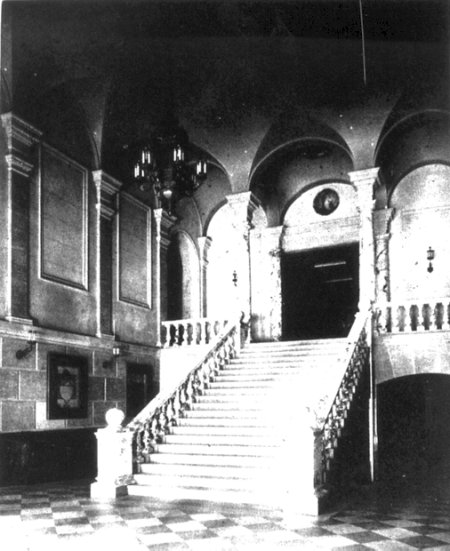
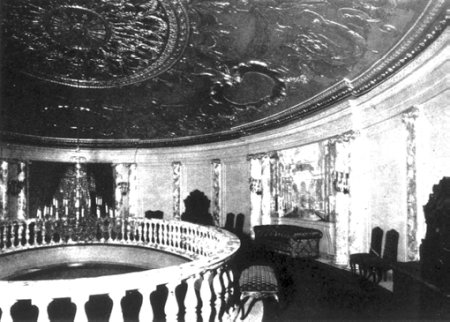
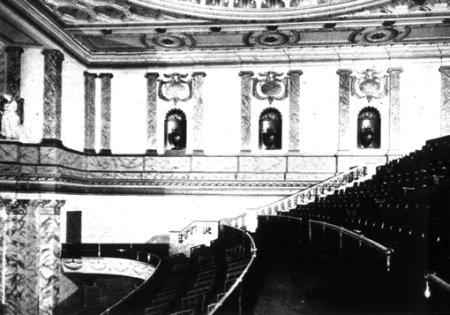
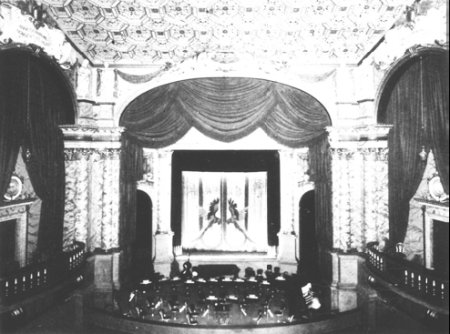
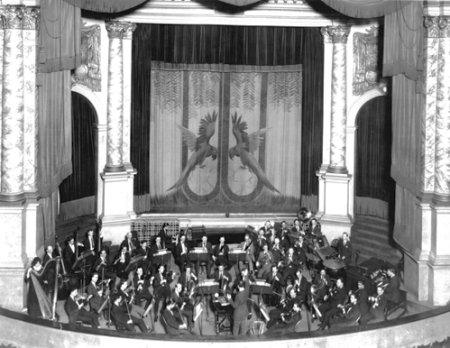


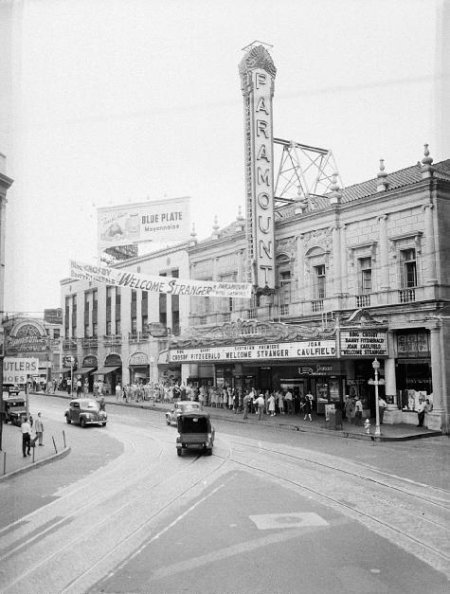
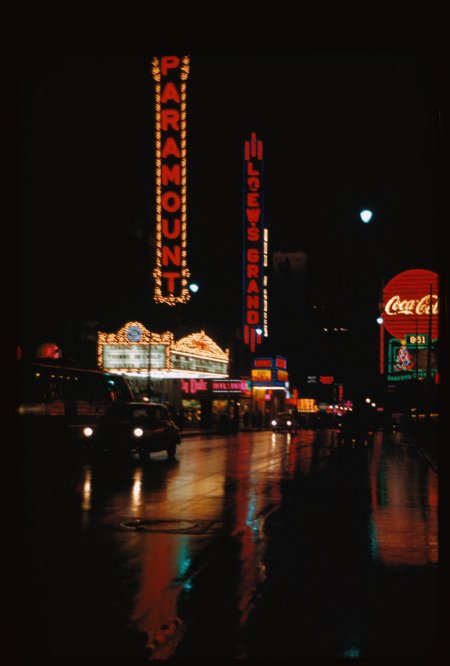
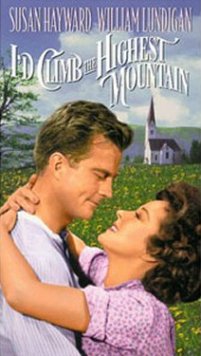

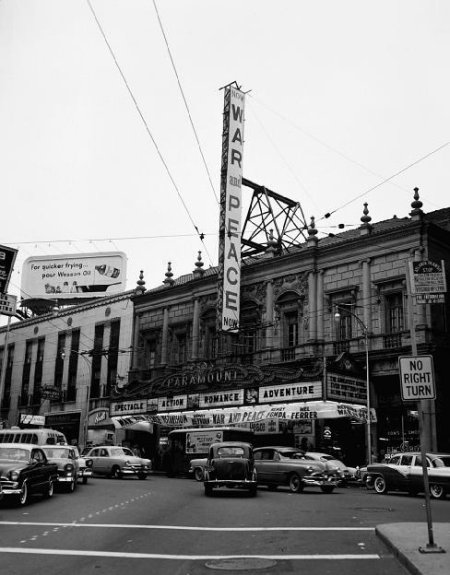
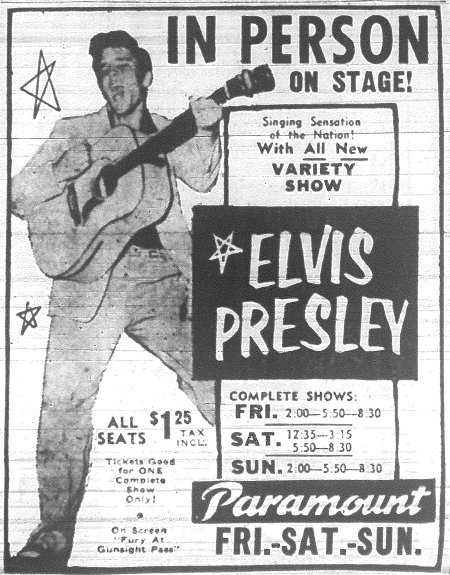
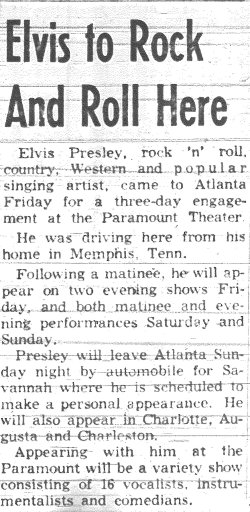 On June 22nd thru the 24th, 1956, Elvis, Scotty, Bill
and DJ appeared at the Paramount for ten performances in three
days. A blurb on page 34 in the advertising section of the Atlanta
Journal-Constitution on the 22nd advertised Elvis' arrival in Atlanta
and announced the shows at the Paramount. It also said, "Appearing with
him will be a variety show consisting of 16 vocalists, instrumentalists and comedians."
On June 22nd thru the 24th, 1956, Elvis, Scotty, Bill
and DJ appeared at the Paramount for ten performances in three
days. A blurb on page 34 in the advertising section of the Atlanta
Journal-Constitution on the 22nd advertised Elvis' arrival in Atlanta
and announced the shows at the Paramount. It also said, "Appearing with
him will be a variety show consisting of 16 vocalists, instrumentalists and comedians."